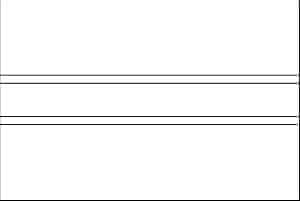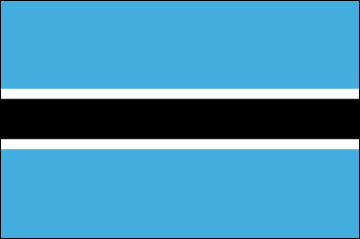
The light blue foundation of the Botswana flag has a black horizontal line running across the centre of it. The colours of the Botswana national flag are the same as those of the country’s coats of arms.
The alternate white and black stripes represent the country’s racial harmony and the liberal nature of society, while the blue represents the ocean. The zebra, Botswana’s national animal, served as the inspiration for the stripes.
The ratio of the stripes is 9:1:4:1:1:9.
| Official Name: | The Republic of Botswana |
| Proportion: | 2:3 |
| Adopted on: | September 30, 1966 |
| Location: | The Republic of Botswana is bordered by South Africa, Namibia, Zimbabwe, and Zambia |
| Capital City: | Gaborone |
| Major Cities: | Wedra, Tshane, Kahg, Mahalapaye |
| Area: | 224,610 square miles |
| Population: | 2,029,307 |
| Currency: | Pula (BWP) |
| Official Languages: | English, Tswana |
| National Anthem: | This Land of Ours |
| National symbol(s): | zebra |
| National colors: | blue, white, black |
| National anthem: | |
| Name: | “Fatshe leno la rona” (Our Land) |
| Lyrics/Music: | Kgalemang Tumedisco MOTSETE |
Historical Background
The current design of the Botswana flag was officially adopted on September 30, 1966, when Botswana gained independence from British colonial rule. The flag’s design was inspired by a competition held to create a new national flag that would represent the aspirations and heritage of the newly independent nation.
Design and Colors
The Botswana flag features a light blue field with a black vertical stripe at the hoist side. On the blue field, there is a white-bordered, black-bordered, light blue horizontal band running from the top left corner to the bottom right corner.
Symbolism of the Botswana Flag
Each element of the Botswana flag holds significant symbolism. The light blue color represents water, which is a precious resource in the arid landscape of Botswana. It symbolizes the country’s commitment to sustainability, as well as its name, “Botswana,” which translates to “Land of Tswana.” The black stripe represents the people of Botswana and their collective strength and determination. The white-bordered, black-bordered, light blue band symbolizes cooperation and cooperation between different races and ethnic groups in Botswana.
Botswana Independence Day
Botswana Independence Day is celebrated on September 30th each year, commemorating the country’s independence from British colonial rule. This day holds special significance for the nation and is an occasion for celebrations, flag-raising ceremonies, and national pride.
FAQs
Q1: When was the current design of the Botswana flag adopted?
The current design of the Botswana flag was officially adopted on September 30, 1966, when Botswana gained independence.
Q2: What do the colors on the Botswana flag represent?
The light blue color represents water and the country’s commitment to sustainability. The black stripe symbolizes the people of Botswana, and the white-bordered, black-bordered, light blue band represents cooperation between different races and ethnic groups.
Q3: What is Botswana Independence Day?
Botswana Independence Day is celebrated on September 30th each year, commemorating the country’s independence from British colonial rule.
Q4: What is the significance of the “Pula” name for the Botswana flag?
The name “Pula” means “Rain” in Setswana, and it is a term of great significance in Botswana due to the country’s arid climate. The name reflects the importance of water and its scarcity in the nation’s landscape.

